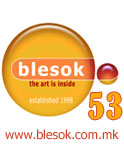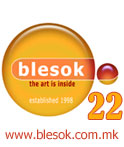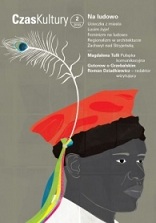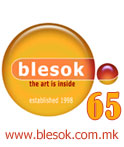
We kindly inform you that, as long as the subject affiliation of our 300.000+ articles is in progress, you might get unsufficient or no results on your third level or second level search. In this case, please broaden your search criteria.







Media-generated fame of the term “folk” made it be associated with various, often disparate ideas: for some, folk denotes mainly quasi-ethnic artistic production of some pop groups, for others it alludes to ambitious and gripping music, which is one of the most significant alternative for the hotchpotch offered by the media. The author of the text, aware of the different attitudes towards folk music, which are generated exactly by the ambiguous associations, writes about the most recent phenomena on folk music scene, introduces bands drawing on the ethnic tradition, mentions folk classics and lists the festivals which attract more and more local and international folk artists every year.
More...
A conversation with Olga Mikhailczuk and Myrosława Ganiuszkina – the organizers of the Ukrainian World Music and Landart Festival “Sheshory”.
More...
Calexico: Carried to Dust [Quarterstick/Touch & Go]
More...


Кон албумот „Порта Маседониа“ на Горан Трајковски и Александар Хофман-Велјанов, „Премиум рекордс“, 2008
More...
On "Porta Macedonia" album by Goran Trajkovski and Alexander Hoffman – Veljanov, "Premium Records", 2008
More...
Calexico: Carried to Dust (Quarterstick/Touch & Go, 2008)
More...
This paper intends to be an inquisition concerning the multivalent preparation of the Classic Canto students by the instrumentality of the piano. The didactic, scholastic and artistic experience demonstrated the fact that the Classic Canto students have the necessary skills and aesthetic abilities both for the vocal interpretation and for the instrumentalist apprehension. It is about a unique kind of relationship between the performer and the musical instrument in a shape and essence unity which is characteristic for the instrumental-vocal chamber music while overlapping the singer and the instrumentalist. Therefore, the entire poetry of the artistic language cannot be perceived and reduced only to the expressiveness and the delight of the vocal intonations but understood within a cohesion and instrumental comprehension.
More...
The Orff-Schulwerk pedagogical model has imposed as one of the most attractive and efficient method of musical education where the rhythm and percussion instruments play a fundamental role. Synchronic perspective, especially the diachronic perspective upon this phenomenon indicates a permanent update and enrichment both of the concept itself and modalities of practical concretization. The present study refers to personal results obtained by the vocal-instrumental children assembly Alpha Lirae that I conduct since 2007, a band that has promoted in Romania and outside the borders a modern musical repertoire based on the exploitation of rhythmic and melodic virtues of Romanian songs with oral tradition. I will highlight the playful dimension of interpreted works by revealing the polyphonic play, techniques of modern composition and coloring that derive from diversification of vocal-instrumental combinations.
More...
Impact of occidental culture on oriental music is recent, and so is the discovery of oriental music by occidental composers. Between modal and tonal systems, from occidental rhythmic span to oriental rhythmical diversity, from the instrumentation of the modern symphony orchestra to the oriental small group of Takht, from the various and ample genres of Occidental music to the accompanied monody specific to oriental music, composers of the twentieth century (both Occidental and Oriental) have searched for the ideal formula to understand, and then to introduce in their creations the atmosphere of another culture. If expressive meaning may be the same (sadness, joy, melancholy, etc.), the expression and, above all, the esthesic capabilities of each cultural public differ significantly . Therefore, the two musical cultures can meet tangentially, they can share certain typical elements, but without “their voices ever to be mistaken, or to lose their own tone and register” (J. During).
More...
Contemporary music education is based on criteria of globality, interdisciplinarity and transdisciplinarity, which even if it focuses on sound language, it is designed constantly on other learning areas involving the ludico-expressive, psychomotor, verbal and logical-mathematical sphere, to which are added the auditory-musical experiences of the child: perception, selection, storage, analysis, notation, handling and production. In the XXI century, music education is no longer a solitary discipline, codified for the untrained people, but rather a social experience of music that belongs to the whole community. Contemporary musical activities, in preschool and school education, are organized in so-called music workshops, where dynamic activities combining music and movement are practiced, education being achieved by musical animation, which replaces the rigid teaching methods and adapts to each individual. Musical animation is a cultural phenomenon, a social practice and a new teaching strategy in music education. This includes three main directions for the application of music education: education for music, education through music and therapy through music. Music education has the noble mission to activate, to raise awareness and to balance the child’s receptivity, giving them opportunity to know the sonorous world by directing them to express through sounds, to promote and develop the potential of the child, rich in expressive-communicative resources, the musical experience being also important in shaping intelligence.
More...
Given the multiple aspects of the post-Wagner opera genre, with a history so heterogeneous and fragmented as to prevent detailed coverage, it would be superficial on our part to attempt a complete presentation of 20th century opera. Limiting ourselves to the new variety of stagings and their reception, we shall dwell on the numerous genre works, their chronological continuity, changes in the perception of syncretism (the various terms applied to the genre – lyrical drama, musical story, monodrama, musical or instrumental theatre, etc.), the particulars of the relationship with theme and dramaturgy types (the verist, post-romantic, impressionist, expressionist, neoclassical), approached languages (tonal, modal, atonal, serial or combinations of these) and the intertwining vocal (cantata, oratorio) or instrumental genres (poem, fantasy and typical structures of autonomous music – invention, fugue, sonata, etc.).
More...